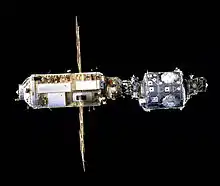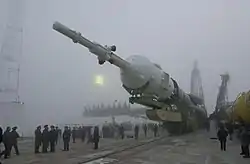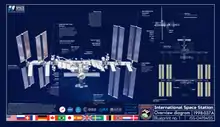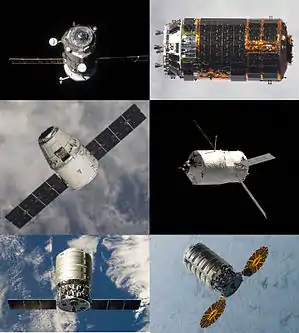International Space Station programme
The International Space Station programme is tied together by a complex set of legal, political and financial agreements between the fifteen nations involved in the project, governing ownership of the various components, rights to crewing and utilisation, and responsibilities for crew rotation and resupply of the International Space Station. It was conceived in 1984 by President Ronald Reagan, during the Space Station Freedom project as it was originally called.[2] These agreements tie together the five space agencies and their respective International Space Station programmes and govern how they interact with each other on a daily basis to maintain station operations, from traffic control of spacecraft to and from the station, to utilisation of space and crew time. In March 2010, the International Space Station Program Managers from each of the five partner agencies were presented with Aviation Week's Laureate Award in the Space category,[3] and the ISS programme was awarded the 2009 Collier Trophy.
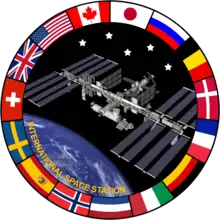 | |
| Manager |
|
|---|---|
| Status | Active |
| Program history | |
| Cost | $150 billion (2010) |
| Duration | 1984–present[2] |
| First flight | Zarya November 20, 1998 |
| First crewed flight | STS-88 December 4, 1998 |
| Launch site(s) |
|
| Vehicle information | |
| Uncrewed vehicle(s) | |
| Crewed vehicle(s) |
|
| Crew capacity |
|
| Launch vehicle(s) | |
History and conception
In the early 1980s, NASA planned to launch a modular space station called Freedom as a counterpart to the Soviet Salyut and Mir space stations. In 1984 the ESA was invited to participate in Space Station Freedom, and the ESA approved the Columbus laboratory by 1987.[4] The Japanese Experiment Module (JEM), or Kibō, was announced in 1985, as part of the Freedom space station in response to a NASA request in 1982.
In early 1985, science ministers from the European Space Agency (ESA) countries approved the Columbus programme, the most ambitious effort in space undertaken by that organisation at the time. The plan spearheaded by Germany and Italy included a module which would be attached to Freedom, and with the capability to evolve into a full-fledged European orbital outpost before the end of the century. The space station was also going to tie the emerging European and Japanese national space programmes closer to the US-led project, thereby preventing those nations from becoming major, independent competitors too.[5]
In September 1993, American Vice-President Al Gore and Russian Prime Minister Viktor Chernomyrdin announced plans for a new space station, which eventually became the International Space Station.[6] They also agreed, in preparation for this new project, that the United States would be involved in the Mir programme, including American Shuttles docking, in the Shuttle–Mir programme.[7]
1998 agreement
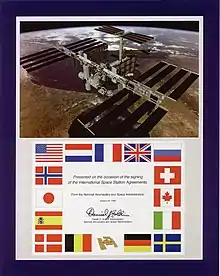
The legal structure that regulates the station is multi-layered. The primary layer establishing obligations and rights between the ISS partners is the Space Station Intergovernmental Agreement (IGA), an international treaty signed on January 28, 1998 by fifteen governments involved in the space station project. The ISS consists of Canada, Japan, the Russian Federation, the United States, and eleven Member States of the European Space Agency (Belgium, Denmark, France, Germany, Italy, The Netherlands, Norway, Spain, Sweden, Switzerland and the United Kingdom).[8] Article 1 outlines its purpose:
This Agreement is a long term international co-operative framework on the basis of genuine partnership, for the detailed design, development, operation, and utilization of a permanently inhabited civil Space Station for peaceful purposes, in accordance with international law.[9]
The IGA sets the stage for a second layer of agreements between the partners referred to as 'Memoranda of Understanding' (MOUs), of which four exist between NASA and each of the four other partners. There are no MOUs between ESA, Roskosmos, CSA and JAXA because NASA is the designated manager of the ISS. The MOUs are used to describe the roles and responsibilities of the partners in more detail.
A third layer consists of bartered contractual agreements or the trading of the partners' rights and duties, including the 2005 commercial framework agreement between NASA and Roscosmos that sets forth the terms and conditions under which NASA purchases seats on Soyuz crew transporters and cargo capacity on unmanned Progress transporters.
A fourth legal layer of agreements implements and supplements the four MOUs further. Notably among them is the ISS code of conduct, setting out criminal jurisdiction, anti-harassment and certain other behavior rules for ISS crewmembers.[10] made in 1998.
Programme operations
Expeditions
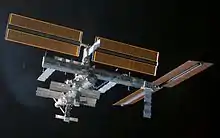
Private flights
Travellers who pay for their own passage into space are termed spaceflight participants by Roscosmos and NASA, and are sometimes referred to as "space tourists", a term they generally dislike.[lower-alpha 1] All seven were transported to the ISS on Russian Soyuz spacecraft. When professional crews change over in numbers not divisible by the three seats in a Soyuz, and a short-stay crewmember is not sent, the spare seat is sold by MirCorp through Space Adventures. When the Space Shuttle was retired in 2011, and the station's crew size was reduced to six, space tourism was halted, as the partners relied on Russian transport seats for access to the station. Soyuz flight schedules increase after 2013, allowing five Soyuz flights (15 seats) with only two expeditions (12 seats) required.[23] The remaining seats are sold for around US$40 million to members of the public who can pass a medical exam. ESA and NASA criticised private spaceflight at the beginning of the ISS, and NASA initially resisted training Dennis Tito, the first person to pay for his own passage to the ISS.[lower-alpha 2]
Anousheh Ansari became the first Iranian in space and the first self-funded woman to fly to the station. Officials reported that her education and experience make her much more than a tourist, and her performance in training had been "excellent."[24] Ansari herself dismisses the idea that she is a tourist. She did Russian and European studies involving medicine and microbiology during her 10-day stay. The 2009 documentary Space Tourists follows her journey to the station, where she fulfilled "an age-old dream of man: to leave our planet as a "normal person" and travel into outer space."[25]
In 2008, spaceflight participant Richard Garriott placed a geocache aboard the ISS during his flight.[26] This is currently the only non-terrestrial geocache in existence.[27] At the same time, the Immortality Drive, an electronic record of eight digitised human DNA sequences, was placed aboard the ISS.[28]Fleet operations
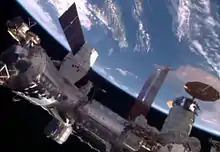
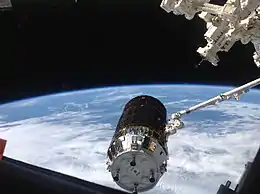
A wide variety of crewed and uncrewed spacecraft have supported the station's activities. Flights to the ISS include 37 Space Shuttle missions, 75 Progress resupply spacecraft (including the modified M-MIM2 and M-SO1 module transports), 59 crewed Soyuz spacecraft, 5 ATVs, 9 Japanese HTVs, 20 SpaceX Dragon and 13 Cygnus missions.
There are currently 8 available docking ports for visiting spacecrafts. [29]
Crewed
Uncrewed
Repairs
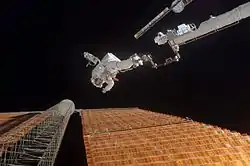
Mission control centres
The components of the ISS are operated and monitored by their respective space agencies at mission control centres across the globe, including:
- Roscosmos's Mission Control Center at Korolyov, Moscow Oblast – controls the Russian Orbital Segment which handles Guidance, Navigation and Control for the entire Station,[35] in addition to individual Soyuz and Progress missions[36]
- ESA's ATV Control Centre, at the Toulouse Space Centre (CST) in Toulouse, France – controlled flights of the uncrewed European Automated Transfer Vehicle[36]
- JAXA's JEM Control Center and HTV Control Center at Tsukuba Space Center (TKSC) in Ibaraki, Japan – responsible for operating the Kibō complex and all flights of the White Stork HTV Cargo spacecraft, respectively[36]
- NASA's Christopher C. Kraft Jr. Mission Control Center at Lyndon B. Johnson Space Center in Houston, Texas – serves as the primary control facility for the United States segment of the ISS[36]
- NASA's Payload Operations and Integration Center at Marshall Space Flight Center in Huntsville, Alabama – coordinates payload operations in the USOS[36]
- ESA's Columbus Control Center at the German Aerospace Center in Oberpfaffenhofen, Germany – manages the European Columbus research laboratory[36]
- CSA's MSS Control at Saint-Hubert, Quebec, Canada – controls and monitors the Mobile Servicing System[36]
Politics

Usage of crew and hardware

There is no fixed percentage of ownership for the whole space station. Rather, Article 5 of the IGA sets forth that each partner shall retain jurisdiction and control over the elements it registers and over personnel in or on the Space Station who are its nationals.[37] Therefore, for each ISS module only one partner retains sole ownership. Still, the agreements to use the space station facilities are more complex.
The station is composed of two sides: the Russian Orbital Segment (ROS) and U.S. Orbital Segment (USOS).[38]
- Russian Orbital Segment (mostly Russian ownership, except the Zarya module)
- U.S. Orbital Segment (mixed U.S. and international ownership)
- Columbus: 51% for ESA, 46.7% for NASA and 2.3% for CSA.[39]
- Kibō: 51% for JAXA, 46.7% for NASA and 2.3% for CSA.[40]
- Destiny: 97.7% for NASA and 2.3% for CSA.[41]
- Crew time, electrical power and rights to purchase supporting services (such as data upload & download and communications) are divided 76.6% for NASA, 12.8% for JAXA, 8.3% for ESA, and 2.3% for CSA.[39][40][41]
Future of the ISS
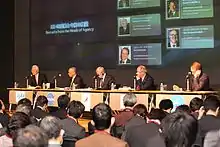
Former NASA Administrator Michael D. Griffin says the International Space Station has a role to play as NASA moves forward with a new focus for the manned space programme, which is to go out beyond Earth orbit for purposes of human exploration and scientific discovery. "The International Space Station is now a stepping stone on the way, rather than being the end of the line," Griffin said.[42] Griffin has said that station crews will not only continue to learn how to live and work in space, but also will learn how to build hardware that can survive and function for the years required to make the round-trip voyage from Earth to Mars.[42]
Despite this view, however, in an internal e-mail leaked to the press on August 18, 2008 from Griffin to NASA managers,[43][44][45] Griffin apparently communicated his belief that the current US administration had made no viable plan for US crews to participate in the ISS beyond 2011, and that the Office of Management and Budget (OMB) and Office of Science and Technology Policy (OSTP) were actually seeking its demise.[44] The e-mail appeared to suggest that Griffin believed the only reasonable solution was to extend the operation of the Space Shuttle beyond 2010, but noted that Executive Policy (i.e. the White House) was firm that there would be no extension of the Space Shuttle retirement date, and thus no US capability to launch crews into orbit until the Orion spacecraft would become operational in 2020 as part of the Constellation programme. He did not see purchase of Russian launches for NASA crews as politically viable following the 2008 South Ossetia war, and hoped the incoming Barack Obama administration would resolve the issue in 2009 by extending Space Shuttle operations beyond 2010.
A solicitation issued by NASA JSC indicates NASA's intent to purchase from Roscosmos "a minimum of 3 Soyuz seats up to a maximum of 24 seats beginning in the Spring of 2012" to provide ISS crew transportation.[46][47]
On September 7, 2008, NASA released a statement regarding the leaked email, in which Griffin said:
The leaked internal email fails to provide the contextual framework for my remarks, and my support for the administration's policies. Administration policy is to retire the shuttle in 2010 and purchase crew transport from Russia until Ares and Orion are available. The administration continues to support our request for an INKSNA exemption. Administration policy continues to be that we will take no action to preclude continued operation of the International Space Station past 2016. I strongly support these administration policies, as do OSTP and OMB.
— Michael D. Griffin[48]
On October 15, 2008, President Bush signed the NASA Authorization Act of 2008, giving NASA funding for one additional mission to "deliver science experiments to the station".[49][50][51][52] The Act allows for an additional Space Shuttle flight, STS-134, to the ISS to install the Alpha Magnetic Spectrometer, which was previously cancelled.[53]
President of the United States Barack Obama has supported the continued operation of the station, and supported the NASA Authorization Act of 2008.[53] Obama's plan for space exploration includes finishing the station and completion of the US programmes related to the Orion spacecraft.[54]
End of mission
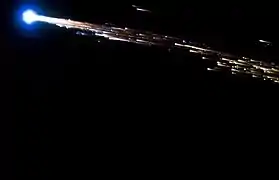
According to the Outer Space Treaty, the United States and Russia are legally responsible for all modules they have launched.[55] Several possible disposal options were considered: Natural orbital decay with random reentry (as with Skylab), boosting the station to a higher altitude (which would delay reentry), and a controlled targeted de-orbit to a remote ocean area.[56] As of late 2010, the preferred plan is to use a slightly modified Progress spacecraft to de-orbit the ISS.[57] This plan was seen as the simplest, cheapest and with the highest margin.[57]
OPSEK was previously intended to be constructed of modules from the Russian Orbital Segment after the ISS is decommissioned. The modules under consideration for removal from the current ISS included the Multipurpose Laboratory Module (Nauka), planned to be launched in spring 2021 as of May 2020,[58] and the other new Russian modules that are proposed to be attached to Nauka. These newly launched modules would still be well within their useful lives in 2024.[59]
At the end of 2011, the Exploration Gateway Platform concept also proposed using leftover USOS hardware and Zvezda 2 as a refuelling depot and service station located at one of the Earth-Moon Lagrange points. However, the entire USOS was not designed for disassembly and will be discarded.[60]
In February 2015, Roscosmos announced that it would remain a part of the ISS programme until 2024.[61] Nine months earlier—in response to US sanctions against Russia over the annexation of Crimea—Russian Deputy Prime Minister Dmitry Rogozin had stated that Russia would reject a US request to prolong the orbiting station's use beyond 2020, and would only supply rocket engines to the US for non-military satellite launches.[62]
On 28 March 2015, Russian sources announced that Roscosmos and NASA had agreed to collaborate on the development of a replacement for the current ISS.[63] Igor Komarov, the head of Russia's Roscosmos, made the announcement with NASA administrator Charles Bolden at his side.[64] In a statement provided to SpaceNews on 28 March, NASA spokesman David Weaver said the agency appreciated the Russian commitment to extending the ISS, but did not confirm any plans for a future space station.[65]
On 30 September 2015, Boeing's contract with NASA as prime contractor for the ISS was extended to 30 September 2020. Part of Boeing's services under the contract will relate to extending the station's primary structural hardware past 2020 to the end of 2028.[66]
Regarding extending the ISS, on 15 November 2016 General Director Vladimir Solntsev of RSC Energia stated "Maybe the ISS will receive continued resources. Today we discussed the possibility of using the station until 2028", with discussion to continue under the new presidential administration. There have also been suggestions that the station could be converted to commercial operations after it is retired by government entities.[67]
In July 2018, the Space Frontier Act of 2018 was intended to extend operations of the ISS to 2030. This bill was unanimously approved in the Senate, but failed to pass in the U.S. House.[68][69] In September 2018, the Leading Human Spaceflight Act was introduced with the intent to extend operations of the ISS to 2030, and was confirmed in December 2018.[70][71][72]New partners
China has reportedly expressed interest in the project, especially if it would be able to work with the RKA. Due to national security concerns, the United States Congress passed a law prohibiting contact between US and Chinese space programmes.[73] As of 2019, China is not involved in the International Space Station.[74] In addition to national security concerns, United States objections include China's human rights record and issues surrounding technology transfer.[75][76] The heads of both the South Korean and Indian space agencies announced at the first plenary session of the 2009 International Astronautical Congress on 12 October that their nations intend to join the ISS programme. The talks began in 2010, and were not successful. The heads of agency also expressed support for extending ISS lifetime.[77] European countries not a part of the International Space Station programme will be allowed access to the station in a three-year trial period, ESA officials say.[78] The Indian Space Research Organisation has made it clear that it will not join the ISS and will instead build its own space station.[79]
Cost
Public opinions
The International Space Station has been the target of varied criticism over the years. Critics contend that the time and money spent on the ISS could be better spent on other projects—whether they be robotic spacecraft missions, space exploration, investigations of problems here on Earth, or just tax savings.[82] Some critics, like Robert L. Park, argue that very little scientific research was convincingly planned for the ISS in the first place.[83] They also argue that the primary feature of a space-based laboratory is its microgravity environment, which can usually be studied more cheaply with a "vomit comet".[84]
One of the most ambitious ISS modules to date, the Centrifuge Accommodations Module, has been cancelled due to the prohibitive costs NASA faces in simply completing the ISS. As a result, the research done on the ISS is generally limited to experiments which do not require any specialized apparatus. For example, in the first half of 2007, ISS research dealt primarily with human biological responses to being in space, covering topics like kidney stones, circadian rhythm, and the effects of cosmic rays on the nervous system.[85][86][87]
Other critics have attacked the ISS on some technical design grounds:
- Jeff Foust argued that the ISS requires too much maintenance, especially by risky, expensive EVAs.[88] The magazine The American Enterprise reports, for instance, that ISS astronauts "now spend 85 percent of their time on construction and maintenance" alone.
- The Astronomical Society of the Pacific has mentioned that its orbit is rather highly inclined, which makes Russian launches cheaper, but US launches more expensive.[89]
Critics also say that NASA is often casually credited with "spin-offs" (such as Velcro and portable computers) that were developed independently for other reasons.[90] NASA maintains a list of spin-offs from the construction of the ISS, as well as from work performed on the ISS.[91][92]
In response to some of these criticisms, advocates of human space exploration say that criticism of the ISS programme is short-sighted, and that crewed space research and exploration have produced billions of dollars' worth of tangible benefits to people on Earth. Jerome Schnee estimated that the indirect economic return from spin-offs of human space exploration has been many times the initial public investment.[93] A review of the claims by the Federation of American Scientists argued that NASA's rate of return from spin-offs is actually "astoundingly bad", except for aeronautics work that has led to aircraft sales.[94]
It is therefore debatable whether the ISS, as distinct from the wider space programme, is a major contributor to society. Some advocates argue that apart from its scientific value, it is an important example of international cooperation.[95] Others claim that the ISS is an asset that, if properly leveraged, could allow more economical manned Lunar and Mars missions.[96]
Notes
- Privately funded travellers who have objected to the term include Dennis Tito, the first such traveller,[16] Mark Shuttleworth, founder of Ubuntu,[17] Gregory Olsen and Richard Garriott.[18][19] Canadian astronaut Bob Thirsk said the term does not seem appropriate, referring to his crewmate, Guy Laliberté, founder of Cirque du Soleil.[20] Anousheh Ansari denied being a tourist[21] and took offence at the term.[22]
- ESA director Jörg Feustel-Büechl said in 2001 that Russia had no right to send 'amateurs' to the ISS. A 'stand-off' occurred at the Johnson Space Center between Commander Talgat Musabayev and NASA manager Robert Cabana. Cabana refused to train Dennis Tito, a member of Musabayev's crew along with Yuri Baturin. The commander argued that Tito had trained 700 hours in the last year and was as qualified as any NASA astronaut, and refused to allow his crew to be trained on the USOS without Tito. Cabana stated training could not begin, and the commander returned with his crew to their hotel.
References
- Harbaugh, Jennifer (August 19, 2015). "August 19, 2015". NASA. Retrieved September 27, 2020.
- Roberts, Jason (June 19, 2020). "Celebrating the International Space Station (ISS)". NASA. Retrieved September 27, 2020.
- "India space station India plans to launch space station by 2030 Space Station". October 18, 2019. Archived from the original on October 19, 2019. Cite magazine requires
|magazine=(help) - ESA - Columbus
- "International Space Station". Astronautix.com. Retrieved May 1, 2012.
- Heivilin, Donna (June 21, 1994). "Space Station: Impact of the Expanded Russian Role on Funding and Research" (PDF). Government Accountability Office. Retrieved November 3, 2006.
- Dismukes, Kim (April 4, 2004). "Shuttle–Mir History/Background/How "Phase 1" Started". NASA. Retrieved April 12, 2007.
- "International Space Station - International Cooperation". Retrieved January 19, 2018.
- "International Space Station Legal Framework". International Space Station. European Space Agency. July 20, 2001. Retrieved September 16, 2006.
- Farand, Andre. "Astronauts' behaviour onboard the International Space Station: regulatory framework" (PDF). International Space Station. UNESCO. Archived from the original (pdf) on September 13, 2006. Retrieved September 16, 2006.
- "International Space Station Expeditions". NASA. April 10, 2009. Retrieved April 13, 2009.
- NASA (2008). "International Space Station". NASA. Retrieved October 22, 2008.
- "SpaceX completes emergency crew escape manoeuvre". BBC NEWS. January 19, 2020.
- Morring, Frank (July 27, 2012). "ISS Research Hampered By Crew Availability". Aviation Week. Archived from the original on May 1, 2013. Retrieved July 30, 2012.
A commercial capability would allow the station's crew to grow from six to seven by providing a four-seat vehicle for emergency departures in addition to the three-seat Russian Soyuz capsules in use today.
- Hoversten, Paul (May 1, 2011). "Assembly (Nearly) Complete". Air & Space Magazine. Retrieved May 8, 2011.
In fact, we're designed on the U.S. side to take four crew. The ISS design is actually for seven. We operate with six because first, we can get all our work done with six, and second, we don't have a vehicle that allows us to fly a seventh crew member. Our requirement for the new vehicles being designed is for four seats. So I don't expect us to go down in crew size. I would expect us to increase it.
- Associated Press, 8 May 2001
- Associated Press, The Spokesman Review, 6 January 2002, p. A4
- Schwartz, John (October 10, 2008). "Russia Leads Way in Space Tourism With Paid Trips into Orbit". The New York Times. Archived from the original on July 22, 2016.
- Boyle, Alan (September 13, 2005). "Space passenger Olsen to pull his own weight". NBC News.
- "Flight to space ignited dreams | St. Catharines Standard". Stcatharinesstandard.ca. Archived from the original on September 12, 2012. Retrieved May 1, 2012.
- "ESA – Human Spaceflight and Exploration – Business – "I am NOT a tourist"". Esa.int. September 18, 2006. Retrieved May 1, 2012.
- "Interview with Anousheh Ansari, the First Female Space Tourist". Space.com. September 15, 2006. Retrieved May 1, 2012.
- Harwood, William (January 12, 2011). "Resumption of Soyuz tourist flights announced". Spaceflight Now for CBS News. Retrieved May 1, 2012.
- Maher, Heather (September 15, 2006). "U.S.: Iranian-American To Be First Female Civilian in Space". Radio Free Europe/Radio Liberty. Retrieved May 1, 2012.
- "Space Tourists | A Film By Christian Frei". Space-tourists-film.com. Retrieved May 1, 2012.
- "Geocaching - The Official Global GPS Cache Hunt Site". www.geocaching.com.
- Cook, John (August 29, 2011). "From outer space to the ocean floor, Geocaching.com now boasts more than 1.5 million hidden treasures". Geekwire.com. Retrieved February 27, 2013.
- "American game designer follows father into orbit". ABC News. October 12, 2008. Retrieved May 16, 2016.
- John Cook; Valery Aksamentov; Thomas Hoffman; Wes Bruner (January 1, 2011). "ISS Interface Mechanisms and their Heritage" (PDF). Houston, Texas: Boeing. Retrieved March 31, 2015.
Docking is when one incoming spacecraft rendezvous with another spacecraft and flies a controlled collision trajectory in such a manner so as to align and mesh the interface mechanisms. The spacecraft docking mechanisms typically enter what is called soft capture, followed by a load attenuation phase, and then the hard docked position which establishes an air-tight structural connection between spacecraft. Berthing, by contrast, is when an incoming spacecraft is grappled by a robotic arm and its interface mechanism is placed in close proximity of the stationary interface mechanism. Then typically there is a capture process, coarse alignment and fine alignment and then structural attachment.
- "Visitors to the Station by Country". NASA.gov. NASA. April 9, 2020. Retrieved May 30, 2020.
- "ESA;— ATV;— Crew role in mission control". Esa.int. March 2, 2011. Retrieved May 23, 2011.
- "ESA — Human Spaceflight and Exploration;— International Space Station;— Automated Transfer Vehicle (ATV)". Esa.int. January 16, 2009. Retrieved May 23, 2011.
- https://spacenews.com/acquisition-of-orbital-atk-approved-company-renamed-northrop-grumman-innovation-systems/
- Gary Kitmacher (2006). Reference Guide to the International Space Station. Apogee Books Space Series. Canada: Apogee Books. pp. 71–80. ISBN 978-1-894959-34-6. ISSN 1496-6921.
- "International Space Station Legal Framework". International Space Station. European Space Agency. July 20, 2001. Retrieved September 16, 2006.
- "A Look at the Russian Side of the Space Station". Air&Space Mag. March 5, 2016. Retrieved March 5, 2016.
- "ISS Intergovernmental Agreement". ESA. April 19, 2009. Archived from the original on June 10, 2009. Retrieved April 19, 2009.
- "Memorandum of Understanding Between the National Aeronautics and Space Administration of the United States of America and the Government of Japan Concerning Cooperation on the Civil International Space Station". NASA. February 24, 1998. Archived from the original on October 29, 2009. Retrieved April 19, 2009.
- "Memorandum of Understanding Between the National Aeronautics and Space Administration of the United States of America and the Canadian Space Agency Concerning Cooperation on the Civil International Space Station". NASA. January 29, 1998. Archived from the original on October 29, 2009. Retrieved April 19, 2009.
- Griffin, Michael (July 18, 2001). "Why Explore Space?". NASA. Archived from the original on August 24, 2007. Retrieved July 31, 2008.
- Malik, Tariq (2008). "NASA Chief Vents Frustration in Leaked E-mail". Space.com. Imaginova Corp. Retrieved November 6, 2008.
- Orlando Sentinel (July 7, 2008). "Internal NASA email from NASA Administrator Griffin". SpaceRef.com. Retrieved November 3, 2008.
- Griffin, Michael (2008). "Michael Griffin email image". Orlando Sentinel. Archived from the original (jpg) on December 16, 2008. Retrieved November 6, 2008.
- "PROCUREMENT OF CREW TRANSPORTATION AND RESCUE SERVICES FROM ROSCOSMOS". NASA JSC.
- "Modification". NASA JSC.
- "Statement of NASA Administrator Michael Griffin on Aug. 18 Email" (Press release). NASA. September 7, 2008. Archived from the original on October 28, 2009. Retrieved December 11, 2008.
- "To authorize the programs of the National Aeronautics and Space Administration". Library of Congress. 2008. Retrieved October 25, 2008.
- Berger, Brian (June 19, 2008). "House Approves Bill for Extra Space Shuttle Flight". Space.com. Imaginova Corp. Retrieved October 25, 2008.
- NASA (September 27, 2008). "House Sends NASA Bill to President's Desk". Spaceref.com. Retrieved November 23, 2008.
- Matthews, Mark (October 15, 2008). "Bush signs NASA authorization act". Orlando Sentinel. Archived from the original on October 19, 2008. Retrieved October 25, 2008.
- Berger, Brian for Space.com (September 23, 2008). "Obama backs NASA waiver, possible shuttle extension". USA Today. Retrieved November 6, 2008.
- BarackObama.com (2008). "Barack Obama's Plan For American Leadership in Space". Spaceref.com. Retrieved November 6, 2008.
- United Nations Treaties and Principles on Outer Space. (PDF). United Nations. New York. 2002. ISBN 92-1-100900-6. Retrieved 8 October 2011.
- "Tier 2 EIS for ISS" (PDF). NASA. Retrieved July 12, 2011.
 This article incorporates text from this source, which is in the public domain.
This article incorporates text from this source, which is in the public domain. - Suffredini, Michael (October 2010). "ISS End-of-Life Disposal Plan" (PDF). NASA. Retrieved March 7, 2012.
 This article incorporates text from this source, which is in the public domain.
This article incorporates text from this source, which is in the public domain. - ""Роскосмос" сообщил дату запуска следующего российского модуля на МКС" [Roscosmos announces the launch date of the next Russian module on the ISS]. RIA Novosti (in Russian). May 23, 2020. Retrieved June 23, 2020.
- Anatoly Zak (May 22, 2009). "Russia 'to save its ISS modules'". BBC News. Retrieved May 23, 2009.
- "DC-1 and MIM-2". Russianspaceweb.com. Archived from the original on February 10, 2009. Retrieved July 12, 2011.
- de Selding, Peter B. (February 25, 2015). "Russia — and Its Modules — To Part Ways with ISS in 2024". Space News. Retrieved February 26, 2015.
- "Russia to ban US from using Space Station over Ukraine sanctions". The Telegraph. Reuters. May 13, 2014. Retrieved May 14, 2014.
- Boren, Zachary Davies (March 28, 2015). "Russia and the US will build a new space station together". The Independent.
- "Russia announces plan to build new space station with NASA". Space Daily. Agence France-Presse. March 28, 2015.
- Foust, Jeff (March 28, 2015). "NASA Says No Plans for ISS Replacement with Russia". SpaceNews.
- Maass, Ryan (September 30, 2015). "NASA extends Boeing contract for International Space Station". Space Daily. UPI. Retrieved October 2, 2015.
- Grush, Loren (January 24, 2018). "Trump administration wants to end NASA funding for the International Space Station by 2025". The Verge. Retrieved April 24, 2018.
- "Commercial space bill dies in the House". SpaceNews.com. December 22, 2018. Retrieved March 18, 2019.
- Cruz, Ted (December 21, 2018). "S.3277 - 115th Congress (2017-2018): Space Frontier Act of 2018". congress.gov. Retrieved March 18, 2019.
- Nelson, Senator Bill (December 20, 2018). "The Senate just passed my bill to help commercial space companies launch more than one rocket a day from Florida! This is an exciting bill that will help create jobs and keep rockets roaring from the Cape. It also extends the International Space Station to 2030!".
- Foust, Jeff (September 27, 2018). "House joins Senate in push to extend ISS". SpaceNews. Retrieved October 2, 2018.
- Babin, Brian (September 26, 2018). "H.R.6910 - 115th Congress (2017-2018): Leading Human Spaceflight Act". congress.gov. Retrieved March 18, 2019.
- Jeffrey, Kluger. "The Silly Reason the Chinese Aren't Allowed on the Space Station". Time. TIME USA, LLC. Retrieved July 2, 2019.
- Mark, Garcia. "International Cooperation". NASA.gov. National Aeronautics and Space Administration. Retrieved July 2, 2019.
- "China wants role in space station". CNN. Associated Press. October 16, 2007. Archived from the original on March 14, 2008. Retrieved March 20, 2008.
- James Oberg (October 26, 2001). "China takes aim at the space station". NBC News. Retrieved January 30, 2009.
- "South Korea, India to begin ISS partnership talks in 2010". Flight International. October 14, 2009. Retrieved October 14, 2009.
- "EU mulls opening ISS to more countries". www.space-travel.com. Retrieved April 2, 2018.
- "India planning to have own space station: ISRO chief". The Economic Times. June 13, 2019. Retrieved July 24, 2019.
- Zidbits (November 6, 2010). "What Is The Most Expensive Object Ever Built?". Zidbits.com. Retrieved October 22, 2013.
- Lafleur, Claude (March 8, 2010). "Costs of US piloted programs". The Space Review. Retrieved February 18, 2012. See author correction in comments.
- Mail & Guardian. "A waste of space". Mail & Guardian. Retrieved March 15, 2009.
- Park, Bob. "Space Station: Maybe They Could Use It to Test Missile Defense". Archived from the original on March 22, 2009. Retrieved March 23, 2009.
- Park, Bob. "Space: International Space Station Unfurls New Solar Panels". Archived from the original on July 4, 2008. Retrieved June 15, 2007.
- NASA (2007). "Renal Stone Risk During Spaceflight: Assessment and Countermeasure Validation (Renal Stone)". NASA. Archived from the original on September 16, 2008. Retrieved November 13, 2007.
- NASA (2007). "Sleep-Wake Actigraphy and Light Exposure During Spaceflight-Long (Sleep-Long)". NASA. Archived from the original on September 16, 2008. Retrieved November 13, 2007.
- NASA (2007). "Anomalous Long Term Effects in Astronauts' Central Nervous System (ALTEA)". NASA. Archived from the original on November 30, 2007. Retrieved November 13, 2007.
- Jeff Foust (2005). "The trouble with space stations". The Space Review. Retrieved March 23, 2009.
- James J. Secosky; George Musser (1996). "Up, Up, and Away". Astronomical Society of the Pacific. Archived from the original on August 8, 2011. Retrieved September 10, 2006.
- Park, Robert. "The Virtual Astronaut". The New Atlantis. Retrieved January 28, 2007.
- NASA (2007). "NASA Spinoff". NASA Scientific and Technical Information (STI). Retrieved November 13, 2007.
- NASA Center for AeroSpace Information (CASI) (October 21, 2005). "International Space Station Spinoffs". NASA. Archived from the original on September 28, 2006. Retrieved September 14, 2006.
- Ginzburg, E.; Kuhn, J. W.; Schnee, J.; Yavitz, B. (1976). "Economic impact of large public programs The NASA experience". NASA Technical Reports Server (NTRS). Retrieved November 13, 2007.
- Federation of American Scientists. "NASA Technological Spinoff Fables". Federation of American Scientists. Retrieved September 17, 2006.
- Space Today Online (2003). "International Space Station: Human Residency Third Anniversary". Space Today Online. Archived from the original on March 2, 2009. Retrieved March 23, 2009.
- RSC Energia (2005). "Interview with Niolai (sic) Sevostianov, President, RSC Energia: The mission to Mars is to be international". Mars Today.com/SpaceRef Interactive Inc. Archived from the original on January 28, 2013. Retrieved March 23, 2009.
External links
| Wikimedia Commons has media related to Category:International Space Station program. |
